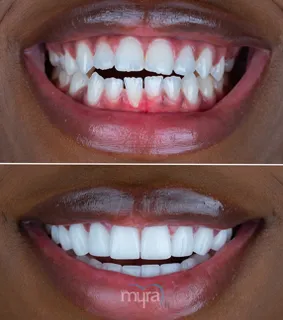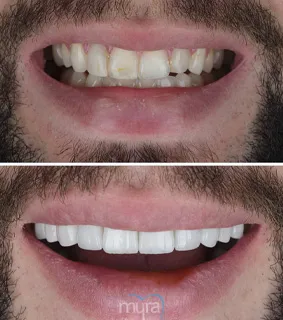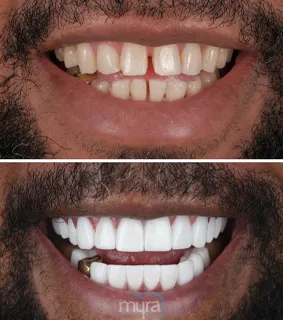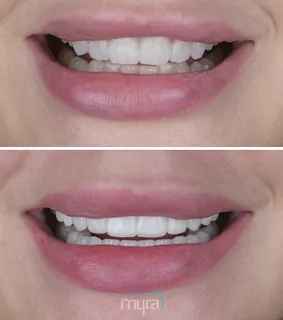Dental onlays pertain to a dental procedure that is performed on broken or decaying teeth. Dental onlays are specially crafted prosthetics that seal the external surface of a tooth to conceal areas beyond the reach of fillings and that do not require a full dental crown. Most people ask, “What is an onlay?” or “What are dental onlays?” They are composed of different substances, such as gold, porcelain, or composite resin, and offer advantages in terms of aesthetics and function. Dental onlays are used to repair teeth that are affected by disease, trauma, or fractures to restore their durability and performance. The dental onlay definition explains its purpose for individuals needing it.
Onlays help with halting further tooth deterioration while maintaining the tooth's original structure by covering and shielding the damaged areas. Dental onlay provides several advantages over dental crowns, one of which is their modest design. Onlay dental treatment needs less removal of healthy dental structures than crowns because they solely cover the damaged section of the tooth, allowing more of the natural tooth to remain. The onlays provide a smooth and natural-looking restoration because they are manufactured to precisely match the colour and shape of the neighbouring teeth.
Dental onlays cost approximately £215 to £265, often more expensive than other dental treatments, which is one of their disadvantages. Its price is influenced by various elements, including the material chosen, the intricacy of the repair, and the dentist's location. Onlays are more expensive in the beginning, but their durability and longevity make them a more cost-effective solution in the end.
Getting a dental onlay often involves more than one step in the process. An onlay is one of the best plans of treatment after the dentist examines the tooth. The dentist removes the decayed or damaged portions of the tooth and takes impressions to make a custom-fitted onlay. The onlay is created and set to the tooth surface with dental cement. The onlay is polished in the last stage to give it a smooth, natural appearance, and restore the tooth's functionality.
What is Onlays?
Onlays are often needed when decay or fracture compromise portions of a tooth for which amalgam or composite fillings are insufficient. For instance, cuspal fractures or residual tooth structures affect the perimeter walls. An onlay is an indirect restoration that covers or onlays the missing cusps. The onlay preserves tooth structure when the solution completely removes cusps and outer walls before repairing a crown.
Onlays are usually made of porcelain or gold, onlays are created outside the mouth and are referred to as inlays. Gold onlays is a well-established practice with a long history. More contemporary varieties of porcelain are now produced that appear to be on par with gold's robustness. The restoration is constructed specifically for the patient while a temporary one is created if the onlay or inlay is created at a dental laboratory. The final prosthesis fitting requires a follow-up visit. Using CAD/CAM dentistry techniques and technologies, porcelain inlays and onlays are made and delivered on the same day.
What is the importance of Onlays?
The importance of Onlays is listed below.
- Restoring Function: Patients chew, bite, and talk once more because of onlays, which restore the tooth's functionality. They are made to endure the pressures of chewing and provide tooth-lasting support.
- Durability: Dental onlays have a long lifespan if maintained and cared for properly. They are a dependable choice for long-term damage restoration and preservation of teeth because of their durability and longevity.
- Enhanced Aesthetic Appeal: Onlays are crafted to precisely mimic the shade and contour of the original teeth, guaranteeing a smooth and organic-appearing repair. Cosmetic improvement raises self-esteem and confidence while improving the smile's attractiveness.
- Eliminating More Damage: Dentists help to stop decay or damage by using onlays to treat tooth problems. Proactively addressing the issue early prevents future larger and more invasive procedures, such as root canals or tooth extractions.
- Moderate Restoration: Onlays are a more conservative treatment option than dental crowns. They merely cover the injured section of the tooth, requiring little removal of healthy tooth structure. The long-term maintenance of dental health depends on the preservation of natural tooth material.
- Protection and Strength: Teeth that are compromised by fractures, rotting, or other problems are strengthened using onlays. Onlays enhance the structure of the tooth and aid in halting further degradation by covering the whole chewing surface.
What is the purpose of Onlays?
The purpose of onlays is to offer an alternative treatment option for moderate tooth decay or injury. The restorations offer a compromise between a simple dental filling and a more complicated dental crown, which is critical for preserving more natural tooth tissue. Onlays are relevant because they provide aesthetically pleasing and long-lasting solutions. Individuals who select onlays effectively restore functionality while maintaining the solidity of their teeth. Patients seek out treatments that prioritise maintaining their natural dentition while treating oral health issues. Onlays are beneficial due to their conservative design, which is consistent with current dental principles. Patients experience increased satisfaction with their general oral and dental health as a result.
Onlays serve to strengthen and reinforce tooth weaker areas by covering the entire chewing surface, preventing further deterioration and risks, including fractures or infections. Onlays improve patients' quality of life and total oral function by restoring their ability to bite, chew, and talk comfortably. Its unique design guarantees a smooth transition with the natural teeth, enhancing the smile's appearance and increasing confidence. Onlays are meant to provide strong, long-lasting solutions for dental restoration, oral health, and smile quality preservation.
Who is a good candidate for Onlays?
A good candidate for onlays is an individual who has teeth with minor damage or decay because onlays are gentle yet effective. Choosing a candidate involves considering some variables, including the patient's preferences, the location of the injured tooth, and the extent of the damage. They work best for people who wish to maintain the majority of their natural tooth structure. Onlays are a good option when the damage is worse than what a simple dental filling allows for but do not require the full coverage of a dental crown. Adults and adolescents benefit from onlays because they are effective regardless of age.
A professional assessment with a certified dentist who assesses the patient's oral health, the condition of the injured tooth, and the planned course of treatment is required before deciding whether or not onlays are appropriate. Onlays are a great option for anyone looking for a long-lasting, strong restoration that provides advantages in terms of functionality and appearance. A thorough dental examination and consultation with a qualified dentist decides whether someone qualifies for onlays. The dentist evaluates each patient's unique needs and goals to identify the best approach.
What factors determine whether a tooth is suitable for an Onlay restoration?
The factors that determine whether a tooth is suitable for an onlay restoration include the condition of the tooth, remaining teeth, position or location of the tooth, and the patient’s oral health. The degree of damage or decay is the first important factor to consider. Onlays are often an excellent option for teeth with moderate to large cavities or areas of damage that are too extensive for a typical filling but not severe enough to necessitate a full dental crown. A tooth with sufficient healthy enamel and dentin to support and hold the onlay usually makes a good candidate, but it's crucial to consider how much healthy tooth tissue is present.
The location of the lesion is assessed, as onlays are very effective for repairing molar and premolar biting surfaces. The patient's maintenance and habits related to oral health are examined. Consistent dental appointments and appropriate oral hygiene practices are crucial for the restoration's long-term effectiveness. The patient's desire for mild therapy is considered, as are their expectations for both durability and aesthetics. The final step in determining whether a tooth is a good candidate for an onlay restoration is a thorough examination by a dentist, which involves X-rays and a visual assessment.
Is a dental onlay often used after a root canal procedure?
Yes, a dental onlay is often used after a root canal procedure. An onlay is a lot less intrusive compared to a crown and needs far fewer teeth to be drilled. The restorations provide the same level of protection for the teeth. Onlays are used by highly skilled dentists because dental bonding chemicals are quite predictable. They are better for the teeth, although it varies according to the dentist's skill level and what they feel most comfortable doing.
A dental onlay is utilised following a root canal operation, depending on the severity of the tooth's damage and the amount of good tooth structure that remains. The inside of the tooth is cleaned of unhealthy or injured pulp during a root canal procedure, which weakens the tooth or makes it more vulnerable to future harm. An onlay is often recommended in situations where the tooth's structure has been seriously damaged to restore strength and functionality. The onlay covers and protects the residual tooth structure, thereby reducing fractures and giving extra support.
Onlays help seal the tooth to stop infection from spreading and improve its appearance. The decision to employ an onlay after a root canal operation is influenced by several variables, including the location and severity of the damage, the patient's oral health needs, and their preferences. The dentist assesses each case separately to choose the best course of action for regaining the tooth's health and function following a root canal.
What is the procedure for Onlays?
The procedure for Onlays is listed below.
- Analyse and evaluate. The dentist begins by performing a thorough examination of the injured tooth to evaluate the level of decay or fracture. X-rays are performed to get a closer look at the tooth's structure.
- Get the tooth or teeth ready. Having determined whether onlays are the better option, the dentist proceeds to prepare the tooth by extracting any rotting or damaged portions. The approach is less invasive, preserving more of the tooth's healthy structure compared to putting dental crowns.
- Scan it digitally with CEREC. Scanning the area around the arch is an easy and quick procedure, which makes it essential.
- Attach to the CEREC milling machine to produce onlay. The computerised design is used to grind the restoration using a 3-axis milling machine. The procedure ensures a durable restoration that matches the original tooth's colour.
- Fit and bind. The patient returns to the dentist for its installation once the onlay is ready. The dentist makes any necessary adjustments and ensures that everything fits perfectly. The completed repair is cemented permanently to the tooth using dental cement.
- Polish it up. The dentist polishes the onlay to provide a smooth surface that enhances the appearance of the natural tooth.
How is a dental onlay placed on a tooth?
A dental onlay is placed on a tooth by carefully positioning it to provide a good fit and long-lasting repair. The initial step is for the dentist to use local anaesthesia to numb the tooth and surrounding tissues for the patient's comfort. The tooth is moulded to fit the onlay and any decayed or damaged regions are removed. Imprints or digital scans are acquired once the tooth is prepared for an onlay that is precisely the right size and form. A temporary repair gets inserted to save the tooth while the permanent onlay is being made in a dental lab.
The patient comes back to the dentist's office to have the onlay placed after it is finished. The onlay is carefully bonded to the tooth surface using dental cement by the dentist after removing the interim repair and completely cleaning the tooth. A good alignment of the bite is examined, and any needed changes are made. The onlay offers the tooth a functional restoration and an aesthetic improvement by polishing it to a smooth finish. Ensuring the most effective outcome for restoring the tooth's integrity and function requires a methodical approach and close attention to detail when placing a dental onlay.
How is the placement of an onlay carried out?
The placement of an onlay is carried out by starting to give local anaesthesia to numb the tooth and surrounding area so that they are comfortable throughout the process. The tooth is carefully moulded to accept the onlay, after which any decayed or damaged regions are meticulously removed. A custom-fitted onlay that closely matches the tooth's shape and size is created using imprints or digital scans once the tooth has been prepared. A temporary repair is sometimes inserted to save the tooth while the permanent onlay is being made.
The tooth is sealed using a temporary filling. The patient comes back to the dentist's office to have the onlay place when it's ready. The tooth is properly cleaned to promote the most effective bonding when the temporary restoration is removed. The second appointment is when the temporary filling is taken out. Digital scanning equipment and conventional methods make it simple to collect measurements of materials that have a dough-like consistency (CEREC Omnicam and Trishape 5). Experts use the digitally created imprint to make a personalised onlay.
The onlay is then meticulously cemented to the tooth surface with dental cement, ensuring a firm and long-lasting fit. The dentist adjusts the bite as needed after verifying that it is properly aligned. The onlay offers the tooth a functional restoration and an aesthetic improvement when polished to a smooth finish. The fitting of an onlay needs a systematic approach and meticulous planning to produce excellent results in restoring the tooth's structure and function.
How long does it take to get an onlay?
It takes up to a day to get an onlay, depending on the condition of the teeth. The length of time it takes to finish onlays depends on the case's complexity and whether the restoration is done on-site or in a modelling unit using CAD-CAM technology. The actual schedule is determined by a variety of factors, including the materials used, the complexity of the restoration, and the digital chairside turnaround time. A comprehensive understanding of the procedure tailored to their needs is ensured when patients discuss with their dentist how long their specific onlay treatment is anticipated to take.
Is getting an onlay a painful procedure?
No, getting an onlay is not a painful procedure. An onlay causes little discomfort because the treatment is performed under local anaesthesia, which numbs the tooth and surrounding tissues. It guarantees that the patient does not feel any pain throughout the onlay placement or tooth preparation and that they remain comfortable during the whole treatment. Some patients feel mild discomfort or sensitivity after the treatment, which is normally short and treatable with over-the-counter pain medicines. Most patients report minimal discomfort throughout the operation and handle it. The process of placing an onlay is not considered as difficult, and any discomfort that occurs is controllable and temporary. Some little discomfort or sensitivity happens during or after the surgery.
What materials are onlays made of?
Onlays are made of the materials listed below.
- Gold: Gold onlays are known for being strong and long-lasting. Their longevity and ability to withstand strong chewing pressures have led to their extensive use in dentistry. Gold onlays are biocompatible and, with the right care, continue for many years even if they are not enamel-coloured.
- Zirconia: Zirconia is a durable and resistant ceramic substance that is finding more applications in dentistry. Zirconia onlays provide superior strength and look when they are custom-shaded to match the natural colour of the teeth. They are safe and resistant to wear and breakage.
- Porcelain: Onlays made of porcelain are stunning and look identical to real teeth. They are a popular option for restoring front teeth or other exposed parts of the mouth because they are long-lasting and stain-resistant. Porcelain onlays are made to match the natural teeth's colour and shape, resulting in a restoration that looks seamless and organic.
- Composite: A material that resembles tooth colour is used to create composite resin onlays, which are glued straight to the tooth. They work well on the front and back teeth because they are adaptable and specially tinted to match the natural colour of the teeth. Composite onlays have aesthetic appeal and durability, however, they aren't necessarily as strong as other materials, such as gold or zirconium.
- Ceramic: Ceramic onlays resemble porcelain onlays in appearance and durability. They are frequently made to resemble the original teeth's colour and shape, making them incredibly attractive. Ceramic onlays are commonly used to restore teeth in the front of the mouth where aesthetics are a top priority.
Do onlays require any special care or maintenance?
Yes, onlays require special care or maintenance. Onlays must be maintained by proper oral hygiene and regular dental checkups to ensure the longevity and health of the restorations. Regular dental care is required to avoid issues, such as gum disease, tooth decay, and damage repair. Inlays and onlays patients are required to follow a strict oral hygiene routine that consists of cleaning their teeth at least twice a day with fluoride toothpaste and flossing every day. There is less risk of plaque buildup and degradation. Use a toothbrush with gentle bristles to avoid causing unnecessary wear on the repair.
Gently scrubbing the gum line and each of the teeth's surfaces ensures effective cleaning while limiting injury. Do not bite down on hard objects or use the teeth as tools. Precautionary steps help prevent any fractures and damage to the inlays and onlays. Pay attention to the dentist's recommendations for regular teeth cleanings and checkups. Checkups help with the early diagnosis of irregularities and a professional cleaning to maintain optimal dental health. Limit the intake of foods and drinks, including coffee, tea, and red wine that are known to discolour teeth.
Dentists recommend wearing a nightguard to minimise excessive force on teeth and restorations while sleeping until people grind their teeth or clench their teeth (bruxism). Seek dental care if there are any difficulties or discomfort, such as bite changes, sensitivity, or restoration damage. Quick action ensures that the onlays continue to work and stop more significant problems. Patients who incorporate onlays into their dental care routines extend the longevity and performance of their restorations. It lowers the chance of problems and enhances overall dental health.
Can onlays be customised to match the colour of my natural teeth?
Yes, onlays can be customised to match the colour of your natural teeth. One of the main benefits of onlays is the ability to look natural because they blend in perfectly with the neighbouring teeth. The dentist utilises several techniques to match the colour of the onlay to natural teeth, resulting in a harmonic and visually pleasing appearance. For example, the dentist chooses the right shade of onlay material to match the colour of the teeth if it is composed of porcelain or composite resin. They make modifications during the placing procedure to achieve a precise colour match. The customisation makes a way for the onlay to be completely integrated into the smile, improving its beauty and maintaining the integrity and function of the tooth.
What are the different types of Onlays?
The different types of Onlays are listed below.
- Gold: A gold onlay is made of a strong and long-lasting gold alloy. They are quite durable and resistant to strong chewing forces. Their long-term dependability, biocompatibility, and durability are advantages. The popularity of more visually acceptable tooth colours is causing gold to lose its appeal as a restorative material. Gold has many benefits, including high strength and ductility that make it perfect for masticatory forces, narrower cross sections that need less loss of tooth tissue, and the necessary qualities for posterior teeth without sacrificing aesthetics. Gold onlays do not match the colour of the teeth and sometimes aren't recommended for visible portions of the mouth. Gold onlays are often more expensive than other materials because of the precious metal utilised, they cost approximately £300 and £600.
- Porcelain: Porcelain onlays are made of ceramic material that is tooth-coloured and closely resembles real teeth. They are quite aesthetically pleasing and integrate well with the neighbouring teeth. Advantages include stain resistance, longevity, and a natural appearance. Porcelain onlays are more susceptible to chipping or fracturing than other materials. Porcelain onlay costs £265 and prices change based on several variables, including the kind of porcelain used, the restoration's complexity, and the location of the dentist office.
- Ceramic: Ceramics are brittle and more prone to break due to a higher risk of breaking when metal support isn't present. Ceramics are placed in thicker cross-sections to lessen flexibility and stop cracks from forming. Ceramic onlays are dental restorations that are strong, long-lasting, and aesthetically pleasing. Zirconia ceramic and conventional ceramic are the two primary kinds. Conventional ceramic onlays are biocompatible, stain-resistant, and resemble real teeth. They are commonly used in noticeable areas, but they are more prone to chipping and breaking. Onlays made of zirconia ceramic are robust and long-lasting, but it is not translucent. Traditional ceramic onlays are less expensive than other options. Ceramic costs £215 and £220 (Zirconia).
- Composite: Resin composite is a prominent dental restorative material that is used for direct and indirect restorations. It is aesthetically pleasing and easily adjustable or repaired. Direct restorations have the opportunity to demonstrate substantial polymerization shrinkage, but lab-made composites exhibit lesser shrinkage due to in-depth curing. It needs more skill and effort, and tooth preparation. The benefits of composites over gold and ceramic inlays and onlays are comparable, while their durability is undetermined. Composite onlays are glued straight to the tooth using resin that matches the tooth's colour. They are adaptable and coloured to blend in with the teeth's natural shade. Advantages include their conservative preparation, direct bonding capability, and attractive look. A composite onlay rarely lasts longer than other materials and must eventually undergo replacement. It costs £275 to £565. Composite onlays are more affordable than gold or porcelain.
How to know which type is suitable for you?
To know which type of onlay is suitable for you, there are factors to consider that include the tooth's location, cosmetic preferences, durability needs, and financial constraints. Aesthetic concerns are important if the restoration is for a front tooth, in which porcelain or composite resin onlays closely mimic the colour and appearance of the natural tooth. Zirconia and gold are stronger and more durable than other materials, making them a better choice for teeth that are subjected to severe chewing forces.
The patient's budget influences the material used, as some types of onlays are more expensive than others. The best kind of onlay for each situation must be determined after careful consultation with a dentist, considering the unique requirements and preferences of the patient. The dentist provides assistance and recommendations based on aspects, such as the tooth's location and health, desired aesthetics, and budget limits, guaranteeing the greatest feasible function and look.
What is the average price of Onlays?
The average price of Onlays is approximately £215 to £265. A few variables that affect the average cost of onlays are the type of material used, the intricacy of the restoration, the practice's location, and any extra operations that are needed. Onlays composed of materials, such as porcelain, zirconia, or gold, are often more expensive than composite resin onlays due to the increased cost of materials and fabrication techniques. The total cost is affected by variables, such as the location and size of the tooth that needs to be restored, the amount of onlays required, and any related dental expenses. The cost of onlays must be discussed with the dentist throughout the treatment planning phase, along with any available payment options or financing plans.
What are the advantages of getting an onlay?
The advantages of getting an onlay are listed below.
- Less Tooth Preparation: Onlays require fewer preparations than dental crowns, which require substantial tooth reduction, preserving more of the native tooth structure. They become a less intrusive and cautious therapy choice as a result.
- Visual Appeal: Onlays offer a seamless and realistic restoration by being manufactured to precisely match the colour, shape, and curves of the actual teeth. Patients feel more confident resulting in a better smile.
- Defends from More Harm: Onlays give teeth more defense against future decay, injury, or fractures by covering the whole chewing surface. It reduces the necessity for more comprehensive and expensive dental treatments in the future.
- Durability and Strength: Onlays are often made of sturdy and long-lasting materials, such as porcelain, zirconia, or gold. There is a lower chance of tooth fracture or damage because the materials are sufficiently sturdy to endure chewing forces and offer long-lasting restorations.
- Maintaining the Natural Structure of the Teeth: Onlays are a more conservative treatment option when compared to dental crowns, preserving a larger percentage of the native tooth structure. It preserves the tooth's vitality and durability while adequately covering areas harmed by trauma or decay.
What are the disadvantages of getting an onlay?
The disadvantages of getting an onlay are listed below.
- Visual Restrictions: The visual appeal of onlays sometimes differs from that of natural tooth structure, even though restorations are made to match the colour and shape of the original teeth. Close examination reveals minute variations in colour or translucency, depending on the substance used.
- Price: The use of high-quality materials and the fabrication procedure make onlays more expensive than standard fillings. Patients need to consider their budget while deciding on onlays, particularly when they do not have dental insurance.
- Level of Sensitivity: Some individuals get temporary sensitivity or discomfort after receiving an onlay. A few people find it irritating, but it tends to be moderate and goes away on its own.
- Fracture Risk: Onlays are durable and shield the tooth from injury, but there is constantly a chance that they get broken, particularly if they are subjected to excessive force or trauma. Patients need to avoid practices, such as chewing on hard things to reduce their risk.
- Several Appointments: An onlay requires at least two dental appointments to complete. Impressions are taken and the tooth is prepped during the initial session. The next step involves the fabrication of the onlay and patients return to have the permanent restoration done.
Are Onlays and dental fillings the same?
No, onlays and dental fillings are not the same. Small to average cavities are commonly sealed with dental fillings, which are placed directly into the prepared tooth cavity. Dental fillings are manufactured from amalgam (metal), composite resin (tooth-colored), or glass ionomer cement. The fillings are a simple option that is commonly put in just one dental appointment and needs very little tooth preparation.
The purpose of onlays is to restore bigger areas of tooth wear or decay, particularly the chewing surfaces of molars and premolars. They are bespoke restorations built on top of one or more cusps of the tooth. They are often made of porcelain, composite resin, or metal, and require more extensive dental preparation than fillings. Onlays and fillings are designed to restore the tooth's appearance and functionality, but they differ in terms of material composition, size, and placement method. The decision between onlays and fillings is based on the patient's needs, cosmetic preferences, and the extent and location of the tooth damage.
What is the difference of Onlays to dental crowns?
The difference between onlays and dental crowns is the coverage of the tooth and the preservation of the tooth's natural structure. An onlay covers a tooth cusp and an inlay just covers the space between the cusps. The tooth's cavity is still drilled, and an onlay is made to precisely fit the space. The entire biting surface of the tooth and the portion of the tooth above the gum line gets covered by a crown. Onlays are often referred to as “partial crowns.” They are conservative restorations used to cover a section of the tooth's surface, usually the chewing surface or one or more cusps. They are used to repair teeth that have moderate to large cavities or damage that is not adequately restored with a filling but is not severe enough to necessitate a complete dental crown.
An onlay is a more gentle repair than a crown because less tooth structure is removed to place the onlay. A crown and an onlay are around the same price. An onlay requires more dental expertise and is more challenging to perform properly. Dental crowns, often known as caps, completely cover the visible area of a tooth above the gumline. Their purpose is to strengthen and maintain teeth that have been severely damaged or weakened, and to enhance the tooth's look. Crowns necessitate more thorough dental preparation, often involving reshaping and shrinking the tooth to make room for the repair.
Onlays and crowns similarly aim to restore the tooth's appearance and function. They differ in how much of the tooth is covered, the degree of preparation needed, and how onlays are placed. The choice between an onlay and a dental crown is influenced by some aspects, such as the level of tooth damage, the tooth's position in the mouth, and the patient's preferences.
What is the difference between Onlays and Inlays?
The difference between onlays and inlays is the degree of tooth covering are the main distinctions between onlays and inlays. Inlays and onlays are examples of indirect dental restorations. Onlays stretch across one or more cusps to repair more extensive areas of tooth damage, while inlays fit inside the tooth's cusps (bumps) and merely cover the chewing surface in between. Onlays simply offer protection that is comparable to that of a dental crown, but they are more conservative than crowns because they leave more of the natural tooth structure intact.
Inlays and onlays are made of porcelain, composite resin, or gold and provide benefits, such as longevity, aesthetics, and utility. The degree of dental damage and the individual requirements of the patient determine whether an onlay or an inlay is best. Onlays are best utilised for bigger cavities that span one or more cusps, while inlays are usually used for minor cavities or areas of decay inside the cusps. Inlays and onlays are efficient ways to restore damaged teeth while keeping natural tooth structure.















